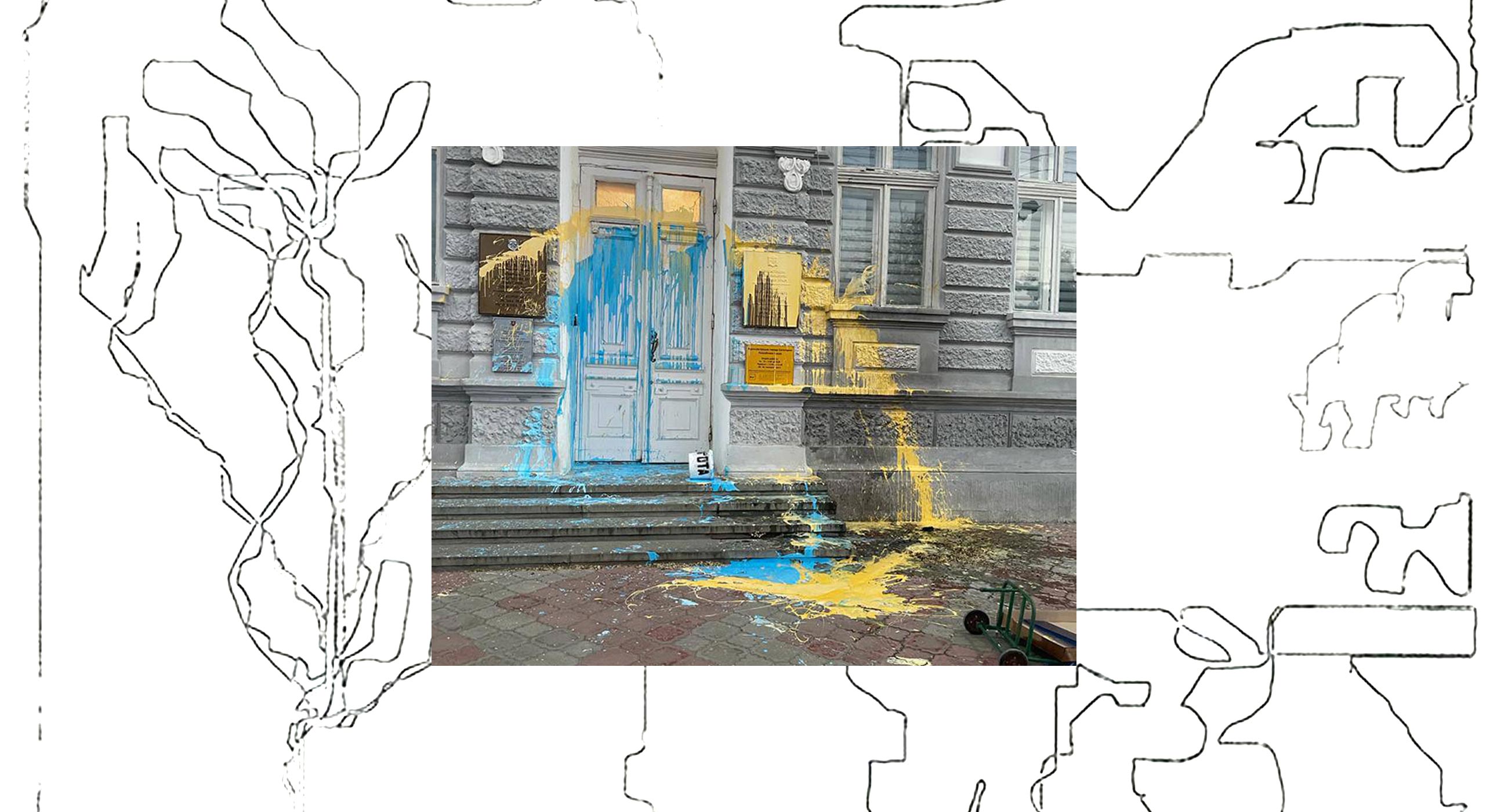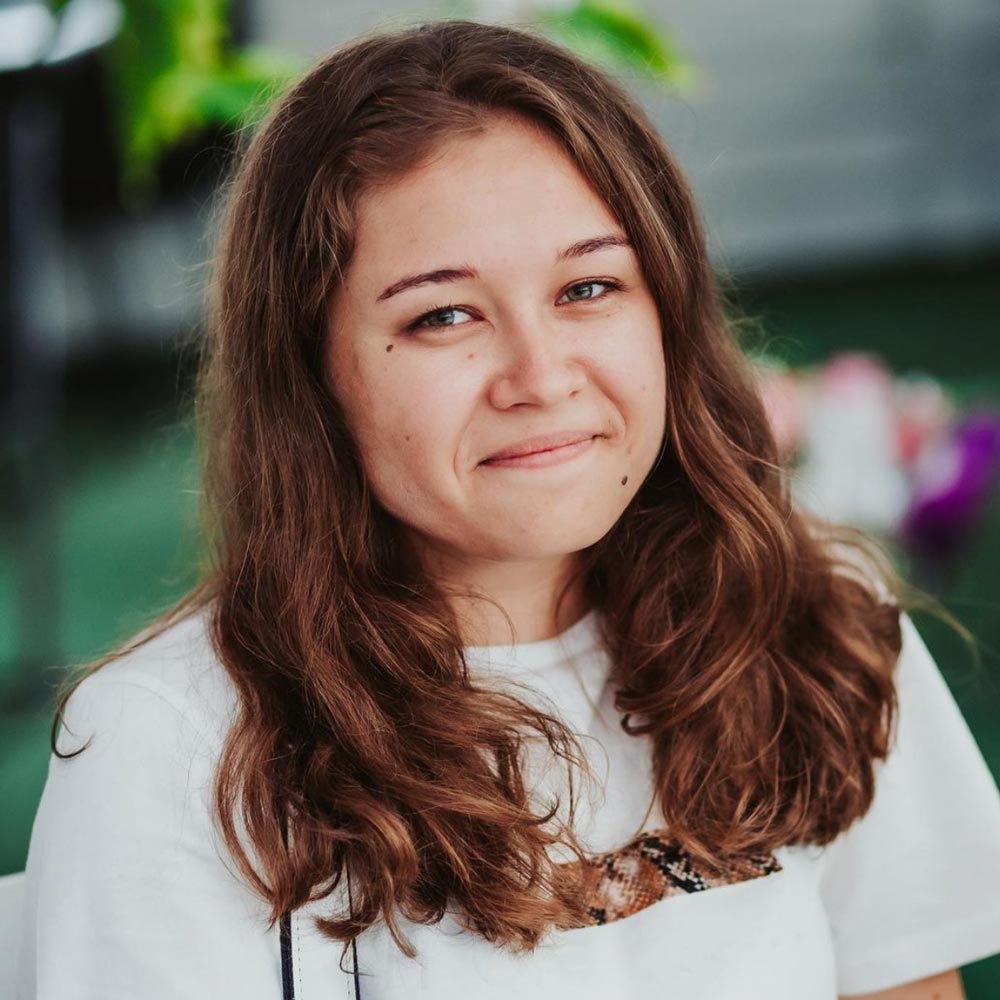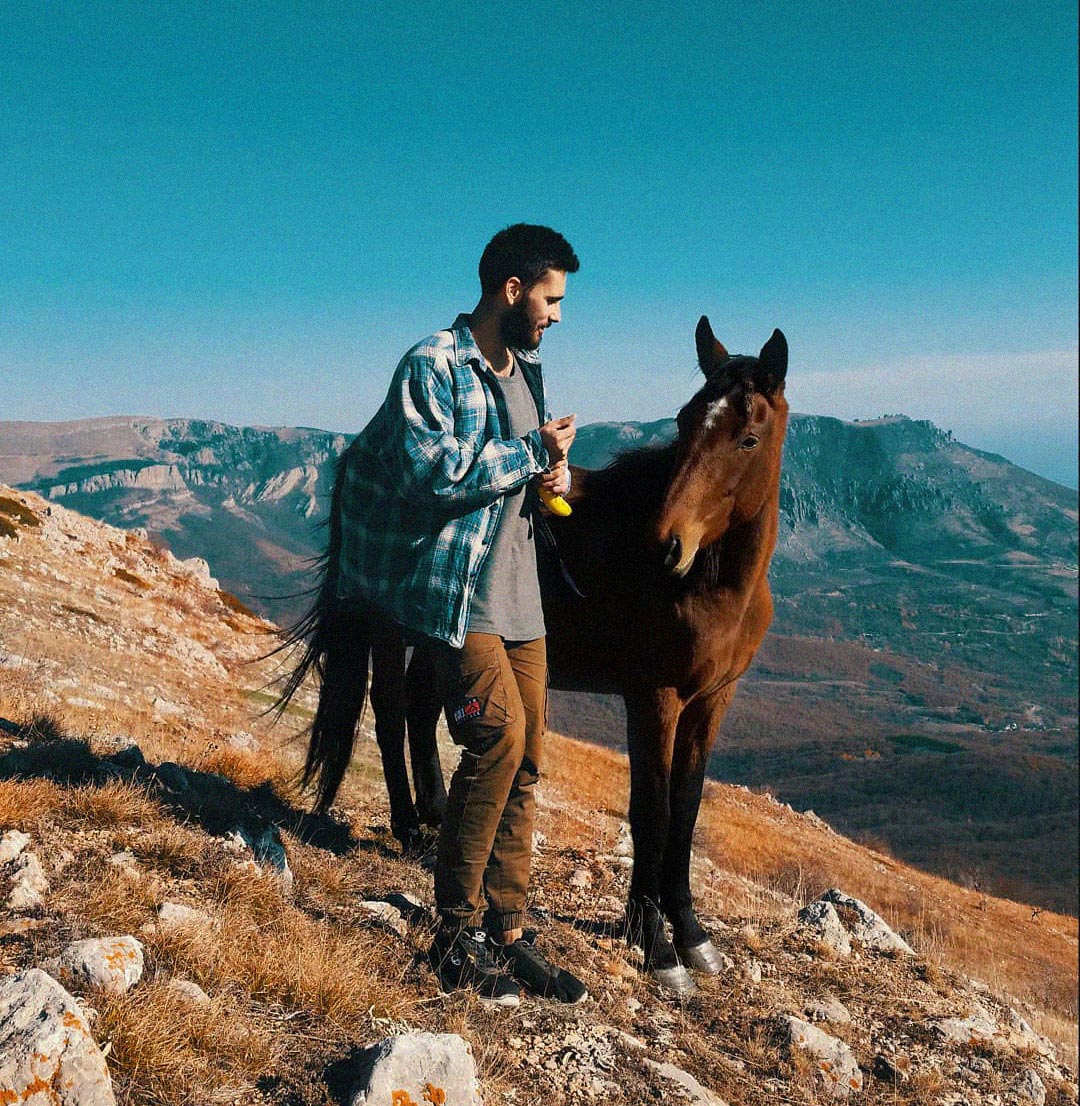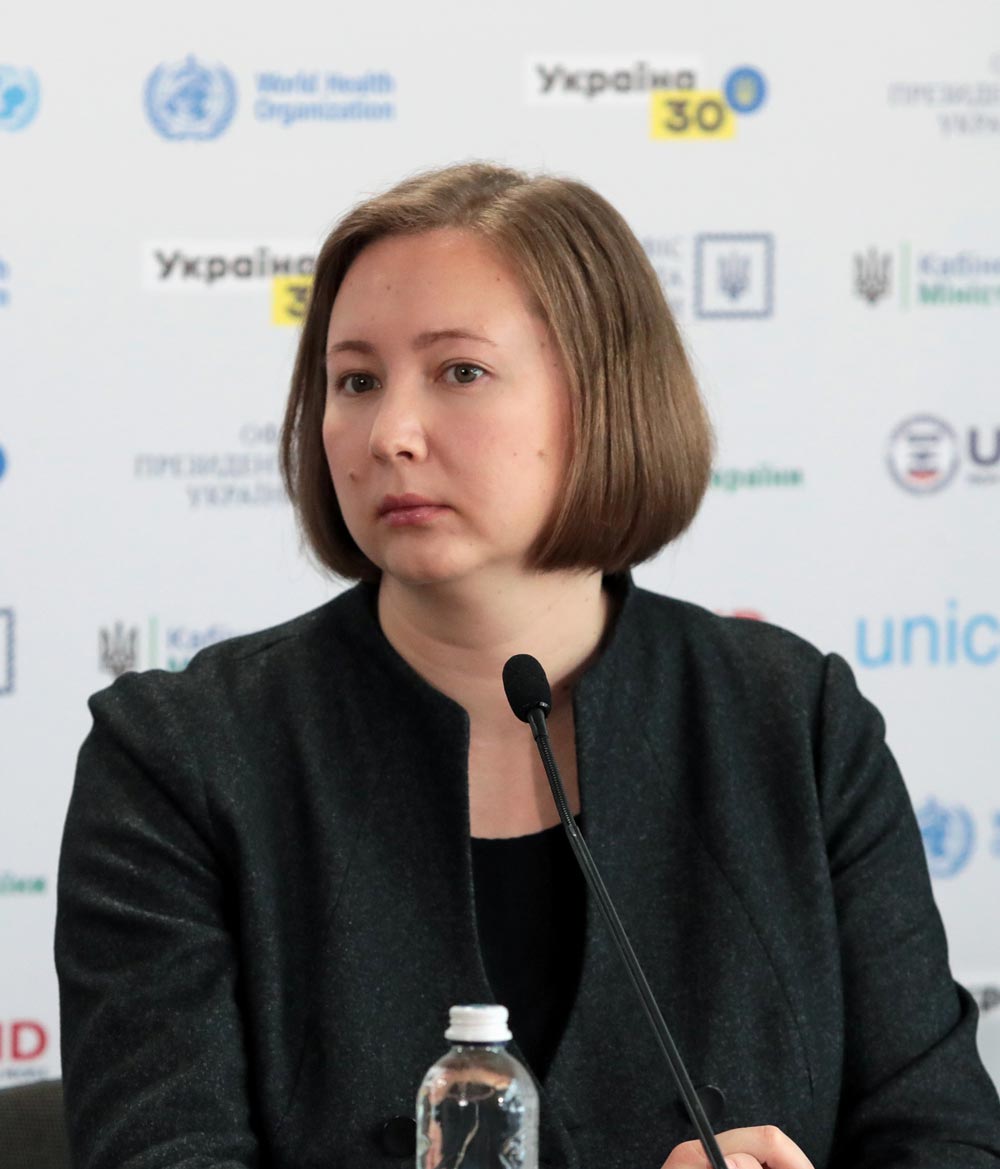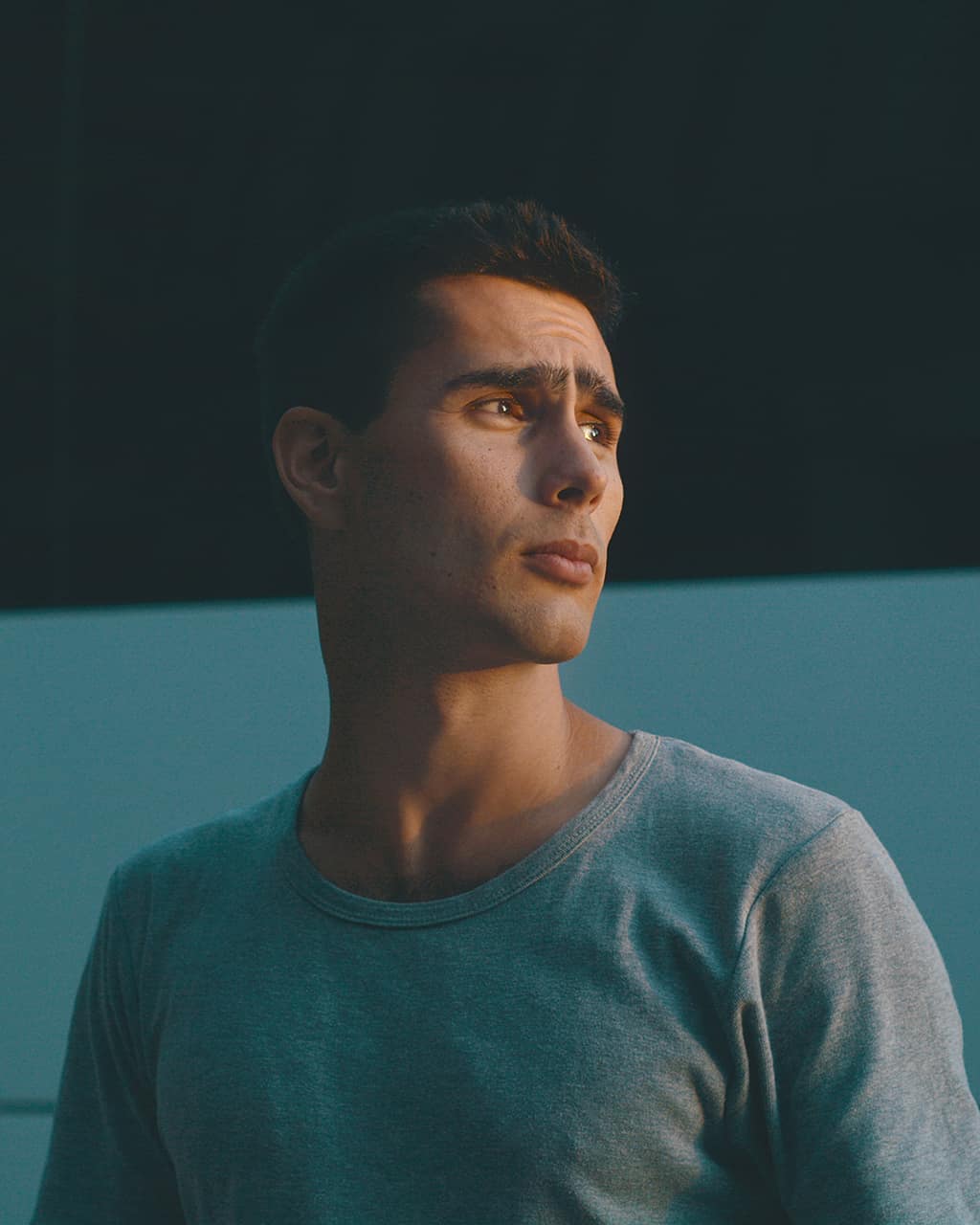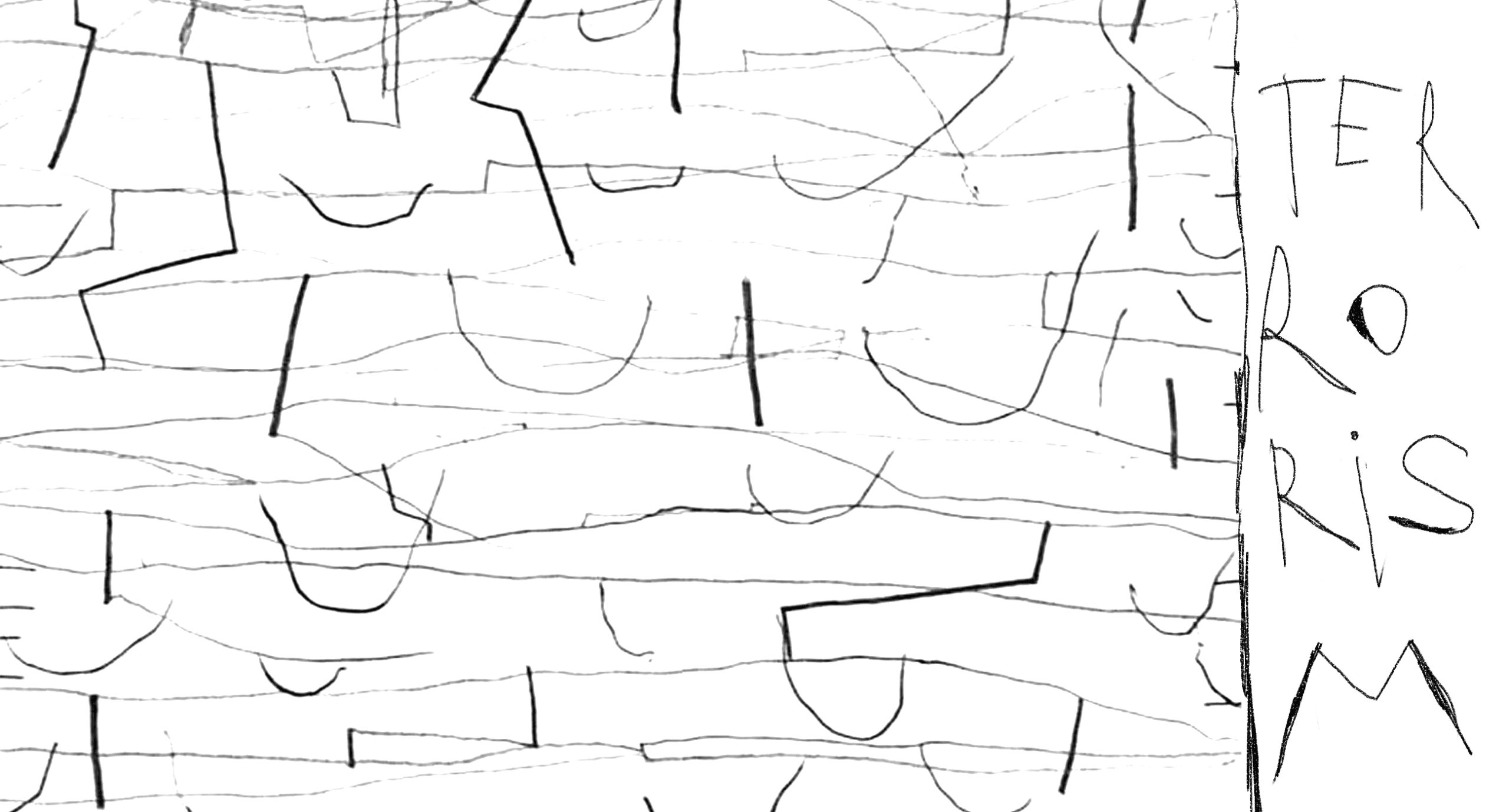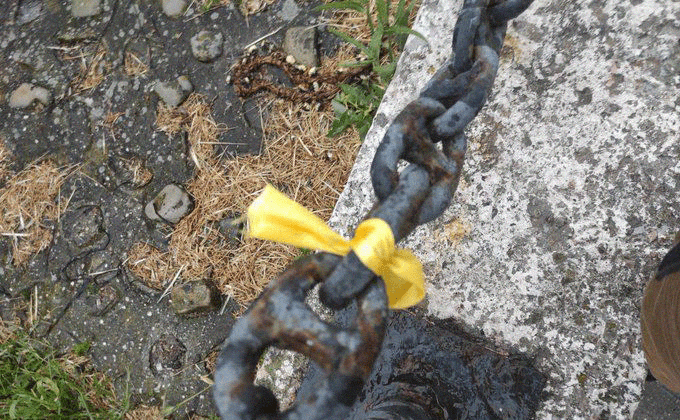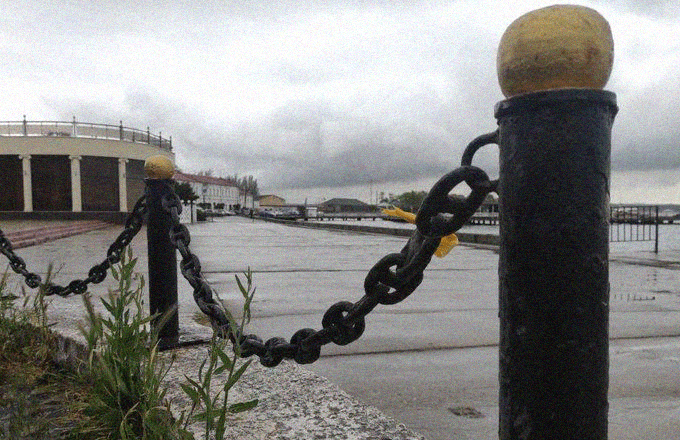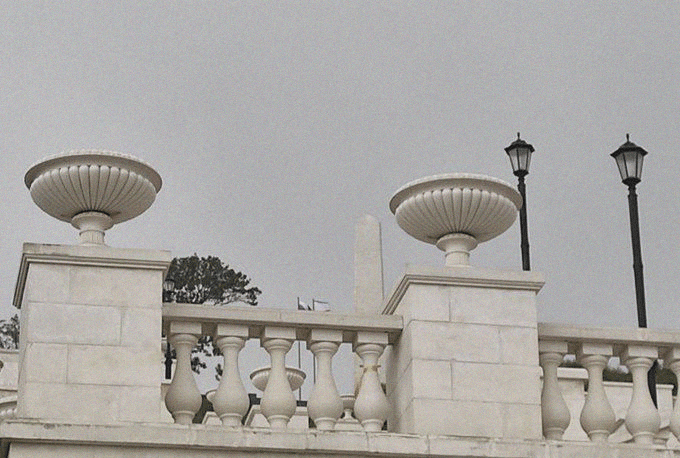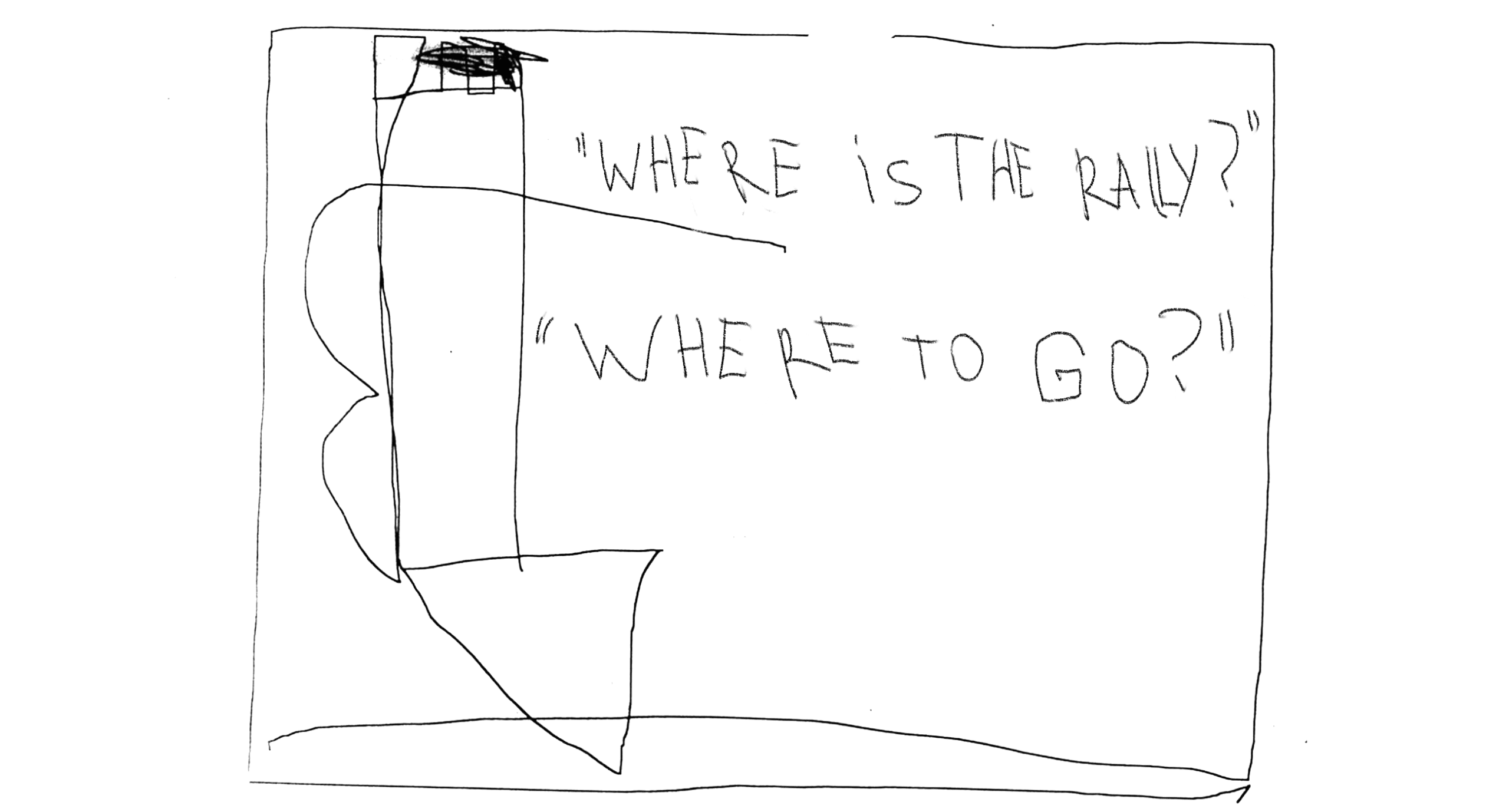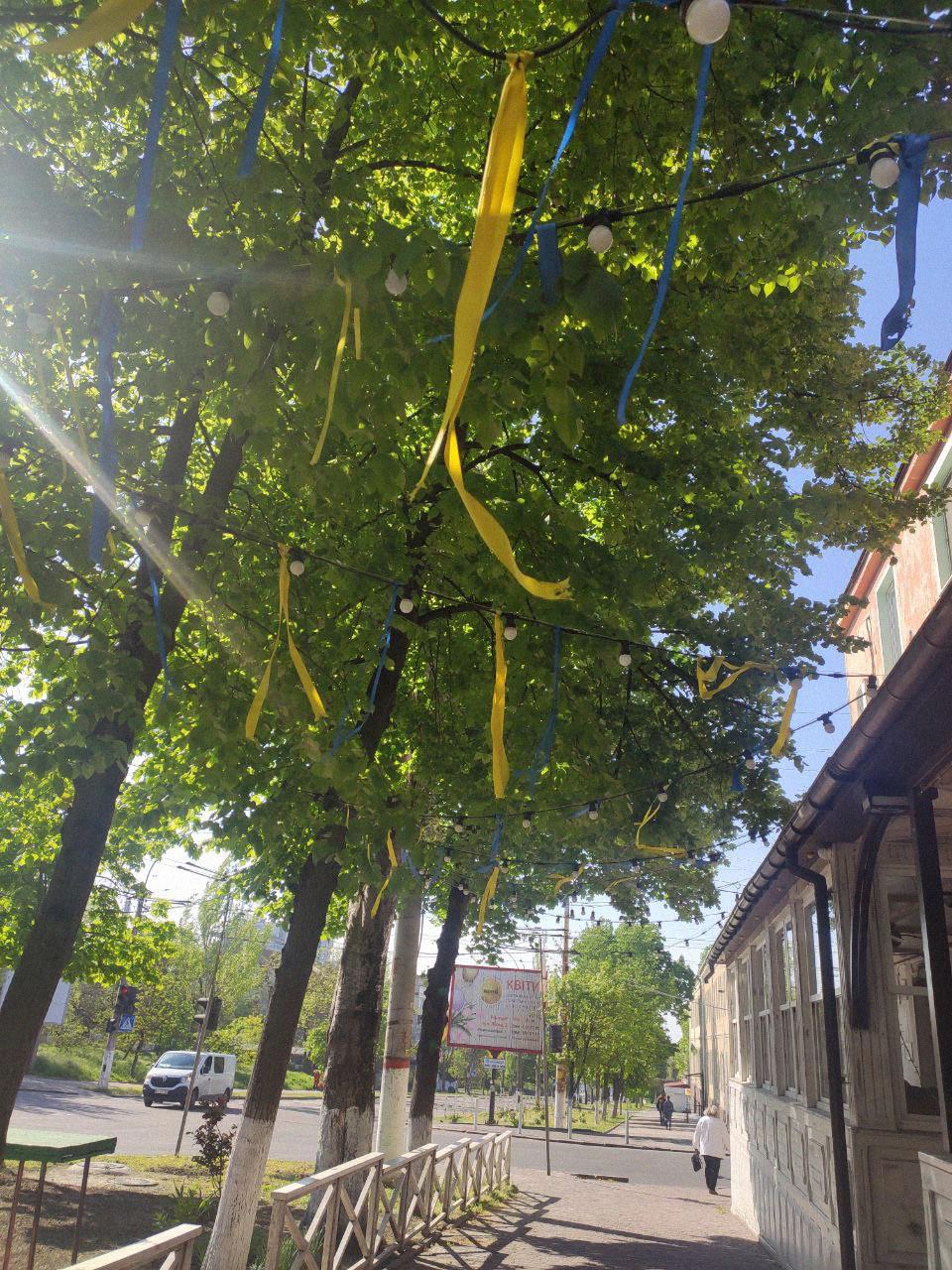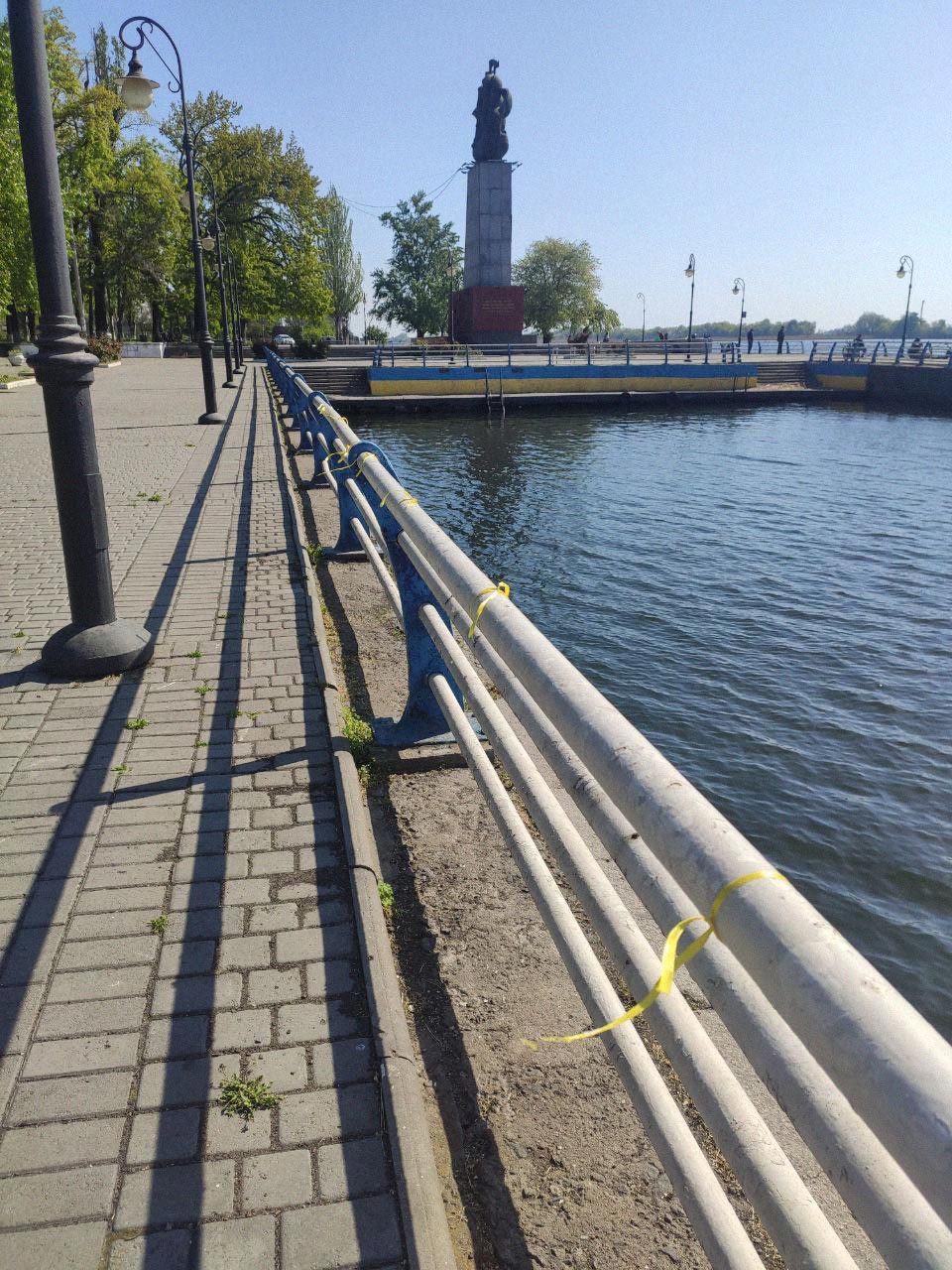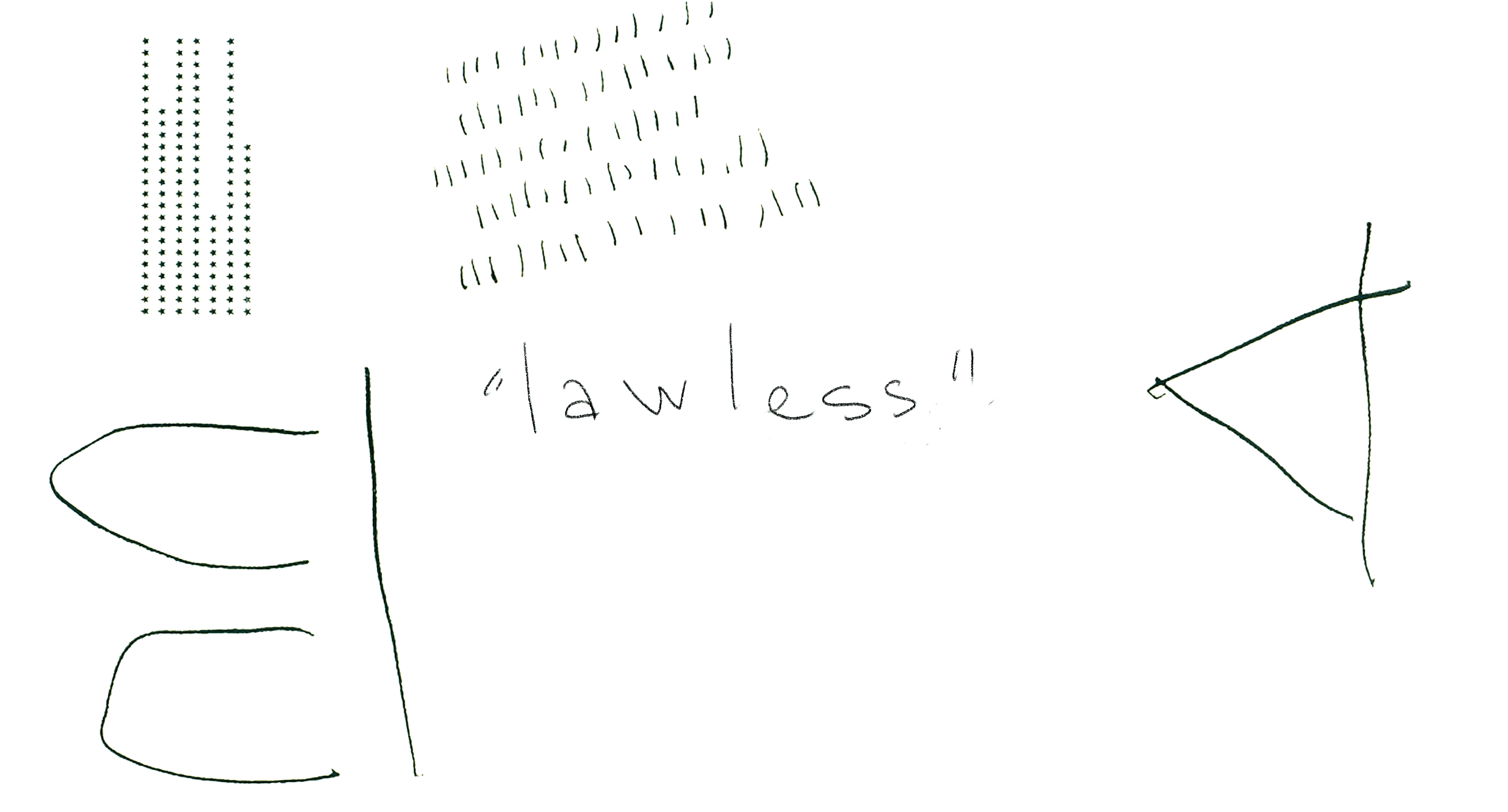Since the beginning of the occupation of the Crimean peninsula, the Russian authorities have been putting constant pressure on dissenters. Searches and arrests, torture, falsified cases and real terms of imprisonment have not stopped for the eighth year already. The state of affairs was also significantly affected by the full-scale Russian invasion of Ukraine. Today Russia, without declaring martial law, actually lives by the laws of war, and security forces detain Crimeans even for a hint of resistance – such as a manicure in yellow and blue colors. In her special report for Zaborona, journalist Liza Sivets talks about how, after almost 10 years under Russian control, the Crimean people continue to resist the occupiers and why they need Ukraine’s support so much.
Bohdan Ziza
On the night of May 16, 2022, in Russian-occupied Yevpatoria, an unknown masked man painted yellow and blue the doors and facade of the city administration. A burning Molotov cocktail flew into the building on the Theater Square in the center of the city. The man, who was caught on video surveillance cameras, was declared wanted.
Later, Crimean propagandist Oleksandr Talipov published a video in which an unknown man himself filmed the doors and the facade of the administration under the track “Patsany Buri” by KALUSH. The unknown also calls on other Crimeans, residents of Russia and Belarus to protest. The voice is unrecognizable, it has been changed.
On the same day, Crimean media and telegram channels published a video in which a 27-year-old resident of Yevpatoria, Bohdan Ziza, claims that he was the one who held the protest. The guy explains this by disagreeing with the “special operation” of Russia on the territory of Ukraine, apologizes to the Crimean people and residents of Yevpatoria, says he is ready to be punished and “atone for his guilt by hard work.”
In the video, Bohdan is in a torn T-shirt, he is visibly nervous. His friends believe that the guy was beaten, intimidated and forced to speak the prepared text for the recording.
“I don’t know if he actually did it or not,” said Oleksandra Barkova, Bohdan’s cousin, who lives in Kyiv. “He felt bad about the war; he did not understand the war. He is a pacifist in general, a very good man. He did not understand all this cruelty. I think he had some kind of protest inside. He may have painted that door. But he did not tell anyone that he planned to do so.”

Oleksandra Barkova
Oleksandra learned that Bohdan was detained by accident. On May 16, the guy stopped responding to messages. In four days, Oleksandra began to worry because Bohdan had never disappeared for so long. She googled his name. And saw the news.
Oleksandra and Bogdan have not seen each other for about 10 years. After 2014, Oleksandra did not visit Crimea, and Bohdan decided to stay there “because he loves Crimea very much.” On his Instagram page there are many photos from the trip to the peninsula. Bohdan was engaged in photo and video shooting, publishing vlogs on his YouTube channel. The day before the Russian invasion of Ukraine, he posted a video of a poem about the war. The guy was fond of parkour and game modeling. He worked as a barista and a waiter, and went to work in factories. According to Oleksandra, Bohdan’s parents were deprived of their parental rights a long time ago and have now died.

Bohdan Ziza in Crimea. Photo: Bohdan Ziza / Instagram
“That’s why we started spreading this information [about Bohdan’s detention],” says Oleksandra, “because he can simply be listed as missing, because there is no one to fight for him. He only has a grandmother there, and she hardly understood his actions if he did it.”
Neither Oleksandra nor the guy’s friends have a relationship with Bohdan. To seek information and legal support, they jointly created the We Are Bohdan Ziza page.
Olha Skrypnyk, chairman of the board of the Crimean Human Rights Group, says that Bohdan Ziza is currently in the Simferopol pre-trial detention center. He is accused under terrorist articles, so he faces a rather long term – up to 15 years in prison. According to Russian media, this is part 1 of Article 205 of the Criminal Code – “explosion, arson or other actions that frighten the population and can lead to death or significant property damage to destabilize the activities of government bodies or influence their decision-making.” She also mentioned part 3 of Article 30 of the Criminal Code – “attempted crime, not completed in circumstances beyond the control of the person.”

Olha Skrypnyk.
Photo: Hennadii Minchenko / Ukrinform / Future Publishing via Getty Images
At the same time, the website of the Russian-controlled court in Yevpatoria published a case dated May 18, according to which Bohdan was sentenced to administrative punishment under Part 1 of Article 20.3.3 of the Administrative Code – “public actions aimed at discrediting the operation of the Russian Armed Forces.” This article provides only fines – not arrest – but Bohdan is still being detained.
Human rights activists suggest that the guy is under pressure.

Photo: Bohdan Ziza / Instagram
“We see that it was a protest against the war unleashed by Russia against Ukraine. Therefore, we understand that he has no chance of fair justice. This is because the entire justice system [in Crimea] is completely loyal to the Kremlin today. And people who show at least some disagreement, as we see by the number of political prisoners, have no such chance,” said Skrypnyk to Zaborona.
Oleksandra Barkova notes that it is important that Bohdan is not accused under other articles – hooliganism or extremism – for other cases committed by other people before. And also that he was not taken out of the Crimea to Russia, because then the situation will take another turn.
“No to war”
This action is not the first of its kind in Crimea. Back in early March 2022, a 17-year-old student was detained in Simferopol for allegedly painting a monument to the Russian occupation military with the colors of the Ukrainian flag. According to the Crimean media, it is a monument to “polite people” in the center of Simferopol. The boy was accused of “vandalism”. In 2019, the same monument was painted red. For this, Russian security forces detained a Crimean citizen Maxym Sokurenko – a citizen of Ukraine who does not recognize the annexation. He was sentenced to 6 months in a penal colony.
The persecution of activists in Crimea continued until the full-scale war, says Olha Skrypnyk, that is, with many people who could resist, Russia tried to deal with in advance. On the eve of the Russian invasion, 116 Crimean political prisoners were already behind bars and nine others were under house arrest.
Immediately after the start of the full-scale war, Russia changed its legislation, introduced new articles, and began to prosecute anti-war slogans administratively. The first fine for the slogan “No to War” was issued in Crimea on March 9. A resident of Simferopol came to the monument to Taras Shevchenko, laid flowers at it, and placed a blue-yellow cardboard plaque with the words “No to War.” On the same day, she was fined 35,000 rubles (about 17,000 hryvnias) for “public display of prohibited symbols.”
Since February 24, inscriptions and drawings with symbols of Ukraine have been recorded throughout Crimea, says Olha Skrypnyk. According to her, citizens of the peninsula were detained also for public statements on social networks. A 46-year-old Yalta resident Olha Dyachenko was detained for a manicure. A local resident reported her. According to him, one of the woman’s nails was painted in blue and yellow, and the other – in red and black. Police conducted a “preventive talk” with the woman and forced her to remove the nail polish.
There are cases of detention of Crimeans for torn flags or posters with the letter Z – a symbol of support for Russia’s war against Ukraine. For example, a 55-year-old Sevastopol resident who cut down a banner in support of the war with Ukraine was fined 30,000 rubles (about 15,000 hryvnias) by a local Russian-controlled court for “discrediting the Russian Armed Forces.”
A 60-year-old resident of the village of Soniachna Dolyna, near Sudak, could be sentenced to 5 years in prison for “desecrating the grave” of a serviceman who died in the war in Ukraine. Local propaganda reports say that the woman allegedly pierced the eyes of a sailor in a photo on a monument. There have also been cases where people have broken windows or punctured the wheels of cars with the letter Z or painted over these symbols.
“Such actions are classified as terrorism. It’s a very hard punishment, a long term – 8, 10, 12 years in prison. Therefore, any, even single protests or actions are very significant. People do it, understanding the consequences,” says Olha Skrypnyk.

Illustration: Kateryna Kruhlyk / Zaborona
The human rights activist also believes that the fact that some people left the Crimea for mainland Ukraine or other European countries in order not to be part of this war is indirect support for anti-war sentiments. This is especially true of men who may be forcibly drafted into the Russian army in Crimea. Skrypnyk emphasizes that if you feel that there are risks, it is still possible to leave the occupied territories and get help – there are appropriate programs for IDPs in Ukraine and abroad.
Yellow ribbon
In May 2022, a call appeared on social networks for Crimeans to go to a joint rally in Simferopol with yellow ribbons – to remind about Ukrainians who stay in the occupied territories. Some suspected that in this way the Russian FSB wanted to identify pro-Ukrainian residents of the peninsula.
However, the coordinator of the Yellow Ribbon non-violent resistance movement, who for security reasons wanted to remain anonymous, says that the organizers of this and other similar actions in southern Ukraine – residents of the Russian-occupied territories. Many of them are still in Kherson, Melitopol, Simferopol.
The movement appeared in late April. “At that time, the entire information campaign of the government was aimed only at Bucha and Borodyanka. And the south of Ukraine was not mentioned anywhere. People thought they had been betrayed, forgotten. And we as a team decided that it would be good to create a peaceful, non-violent symbol of resistance. It was a yellow ribbon. And the blue [ribbon] is a symbol of support for the occupied territories in peaceful [non-occupied] cities,” the movement’s coordinator explained in an interview with Zaborona.
Prior to the rally in Simferopol, activists of the movement held several rallies in other occupied cities. The first, on April 27 in Kherson, gathered approximately 500 people. On May 9, about a hundred people took part; about 15 of them were detained. On the same day, there were detentions in Nova Kakhovka – the Russians took away people in yellow clothes, who were just standing in the square. Then the Russian Guard detained one of the organizers of the movement, took her “to the basement”, interrogated her and told her to leave the city.
The rally in Simferopol was scheduled for May 18, the Day of Remembrance of the victims of Crimean Tatars deportation. The “visit” button on the Facebook event was clicked by 3,000 people. For two days the organizers verified them, eliminated fake pages. The tested participants were divided into three separate groups and invited to the chats.
Crimean Tatar activists were not specially involved – the day before they received warnings from the security forces not to take part in any actions.
In the end, about 150 people took part in the rally – three groups at three different locations. One of the locations is the square next to the Taras Shevchenko monument. The other two places were not named by traffic coordinators for security reasons, but they are also located away from the center. After all, many paddy wagons were on duty near the central square that day.
“We have distracted the security forces. We were told that in the Kherson direction they departed a little, some checkpoints were removed because of this [rally]. Therefore, the rally also benefited the Armed Forces,” says the coordinator of the Yellow Ribbon. “Nobody was detained. But the FSB are still threatening us, calling our relatives, trying to find us. That day, they [undercover security officers] wrote a lot: “Where is the rally? Where are we gathering? Where to go?”

Illustration: Kateryna Kruhlyk / Zaborona
The participants of the rally did not use patriotic slogans, but only honored the memory of Crimean Tatars and hung yellow ribbons on the trees and fences. If it weren’t for the heavy rain, there would be many more people on the street, the traffic coordinator is sure. The organizers also received proposals to involve Yevpatoria, Saky, and Sevastopol. And in Kerch someone himself hung the yellow ribbons in the city center – the organizers were sent photos.
According to the coordinator of the Yellow Ribbon, the mood in the south is patriotic, people are ready to go out, ready to stand for their ideas. Regarding the potential danger, he said: “We do not encourage or force people to leave. This is their decision. We need even an information victory here. When people understand this, they agree with us.”
Resistance in isolation
In addition to cleaning up civil society, Russia has also been cleaning up the information space. According to Olha Skrypnyk, all sites of Ukrainian media and human rights organizations are currently blocked on the peninsula, and social networks are limited.
This is confirmed by the coordinator of the Yellow Ribbon: “They are trying to block our sites. Russian propaganda channels sling mud on us. It affected them.”
The Crimean Human Rights Group, which Olga represents, was recently recognized by the Russian Prosecutor General’s Office as an undesirable organization. In fact, their activities are banned in Russia and the Russian-occupied territories. In conditions of isolation from information, it is difficult to imagine mass protests, if thousands took to the streets, says Olha.
“At the same time, we see how the people of Kherson have heroically defended their interests and are defending Ukraine, despite the fact that they are already under the occupation not even of the occupying power, but of Russian troops. These heroic and very strong steps of our citizens deserve respect. Just like the people who put up any resistance in the Crimea. But we must understand that this is everyone’s personal choice. What he is capable of, what he is ready for. What he is ready to lose for the sake of Ukraine, for the sake of his values, for the sake of freedom. But I believe that we must support all our citizens, regardless of whether they are in prison or freed, and do everything possible to liberate them later. Both the newly occupied territories and Crimea,” says Olha Skrypnyk. “Of course, it is dangerous. But many people take risks and will do this. I think this is an important feature of Ukrainians who know the price of freedom and are willing to pay it. And even now we read letters from our political prisoners from Russian prisons or the Crimean pre-trial detention center – we see that people are behind bars, but they were not broken. They are writing words of support for Ukraine, and they are ready to wait until they are released – the main thing is that Ukraine wins. I think these are important values for all of us. Of course, any resistance now deserves respect, so that we know about it. In Crimea, in Kherson, in Zaporizhzhya – wherever our people resist. It is important for these people to understand that Ukraine knows about them.”
Recently, the repression of civilian journalists has intensified in Crimea. One of the new cases is against Iryna Danylovych, who covered human rights violations. On April 29, 2022, Iryna’s house in the village of Vladyslavivka near Feodosia was searched. According to the journalist’s mother, security officers confiscated a phone and a laptop. On the same day, Iryna was arrested at a bus stop, after which it was unknown for almost two weeks where she was being held.
Danylovych’s detention was a forced disappearance, she was pressured both physically and psychologically, says Skrypnyk. According to the Crimean Human Rights Group, Iryna Danylovych was detained for eight days in the basement of the FSB building, tested on a polygraph; they put a bag over her head, and threatened to take her to the forest if she hid anything. All this time she was fed once a day, taken to the toilet – twice a day. In the end, they offered to sign blank forms in exchange for release. When she did, she was told that 200 grams of explosives had been found in her purse and taken to court. Iryna Danylovych was charged under Part 1 of Article 222.1 of the Criminal Code – “illegal acquisition, transfer, sale, storage or transfer of explosives.” According to independent lawyer Ayder Azamatov, a measure of restraint was chosen for her only on May 7 with the mediation of a lawyer (provided by the state).
This case is completely “lawless”, as it was in 2014, when power turned a blind eye to formal procedural matters and did whatever they wanted. All doors are open to them, they can resort to any repression without any restrictions. And for all journalists and activists who remain in Crimea, the peak of risk is now. While the full-scale war is going on, the possibilities to protect them are minimal,” Skrypnyk said.

Illustration: Kateryna Kruhlyk / Zaborona
First, the human rights activist advises finding an independent lawyer. After all, the state one usually represents the interests of Russia – forcing a person to enter into an agreement with the investigation, cover torture. An independent lawyer is an opportunity to protect, establish a connection, and have information about your relatives who are in places of detention.
Secondly, it is important to make the case public, to be open to communication and to keep in touch with human rights activists, says Skrypnyk: “It is important that relatives do not remain silent. Don’t think that if you keep quiet, something will be better. In our experience, and we’ve worked with over 120 cases, it doesn’t work. Publicity works. When the Ukrainian authorities know about the prisoners, international experts know.”
One of the tools is mentoring programs, where well-known public figures, diplomats, writers or journalists take care of the fate of one of the political prisoners. According to Skrypnyk, this increases the chances that a person will not be forgotten or tortured, that he will at least stay alive, and at most – will be included in the lists for exchange.
“Yes, this is not a very legal way,” says Olha. “But this is the only political mechanism through which people can be released, as was the case in 2019 with Oleh Sentsov.”

